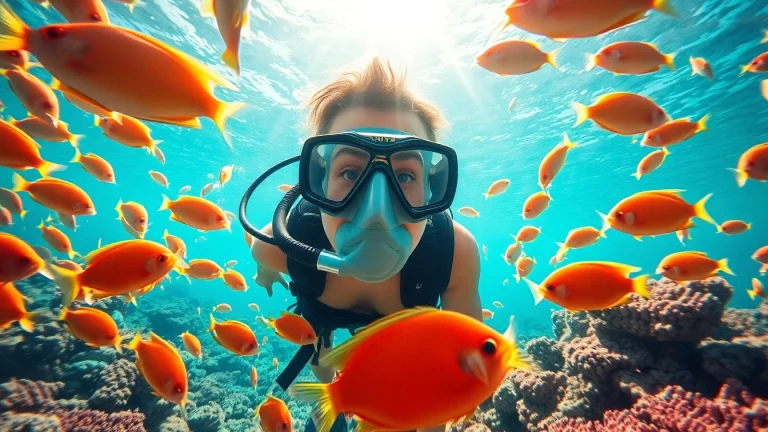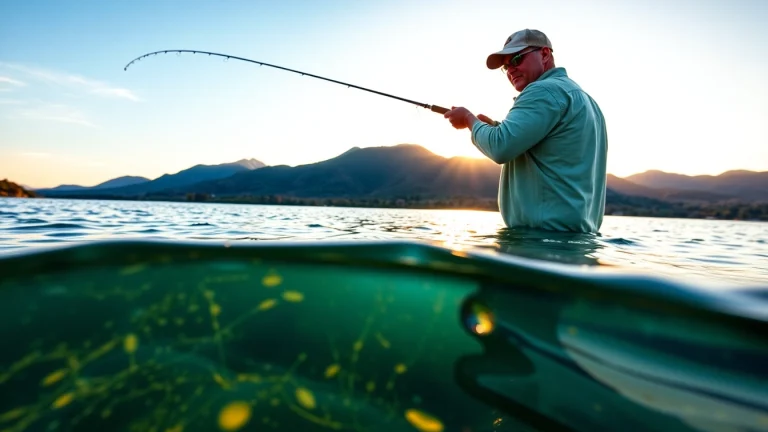
Mastering Saltwater Fly Fishing: Essential Techniques and Gear for Success
Understanding the Basics of Saltwater Fly Fishing
What is Saltwater Fly Fishing?
Saltwater fly fishing is an exciting and challenging pursuit that involves using a specialized type of fly fishing gear to catch saltwater species. Unlike traditional fishing methods that rely on bait, fly fishing utilizes artificial flies that mimic the look and movement of prey fish, insects, or crustaceans. Anglers cast these flies using a fly rod and line to entice fish, making it an active and engaging form of fishing that provides anglers with not only the thrill of the catch but also an appreciation of the environment.
For those interested in exploring the seawater’s depths with a fly rod, the right techniques, equipment, and knowledge about the ecosystem are essential for success. Saltwater fly fishing combines skill, strategy, and an understanding of tides and fish behavior to create memorable fishing experiences.
Key Differences from Freshwater Fishing
While both freshwater and saltwater fly fishing share similar techniques and gear, several key differences set them apart. One major distinction lies in the environment. Freshwater fishing typically occurs in lakes, rivers, and streams, while saltwater fishing takes place in oceans, bays, and estuaries. This switch in environment brings about different species, challenges, and tactics. Saltwater fish often exhibit different feeding behaviors and require a greater understanding of their habitats.
Moreover, the gear used in saltwater fly fishing is generally more robust. Saltwater environments are harsher, and the fish found in these waters, such as tarpon and bonefish, are often larger and more powerful. Therefore, saltwater anglers require durable rods, reels with strong drag systems, and various other specialized gear to withstand the saltwater and fight these vigorous fish.
Essential Gear Overview
To embark on the saltwater fly fishing journey, one must be equipped with the right gear. Key components include:
- Fly Rod: Typically longer and sturdier, ideally ranging in weight from 8 to 12 for saltwater species.
- Fly Reel: Able to withstand saltwater corrosion, these reels typically feature a strong drag system for larger fish.
- Fly Line: A heavier line that can cast effectively in windy conditions and can handle the rough seas.
- Leaders and Tippets: Important for connecting the fly to the line, fluorocarbon leaders are preferred for their invisibility in water.
- Flies: Selection and usage of patterns that can successfully mimic bait species like shrimp, crabs, and minnow.
Choosing the Right Equipment for Saltwater Fly Fishing
Saltwater Fly Rods and Reels
When exploring options for saltwater fly rods, it’s vital to consider the weight, length, and action. Rods typically range from 8 to 12 weights, with 9-weight being a versatile choice suitable for many species. Length can vary, but longer rods (9-10 feet) offer better casting distance and line control in challenging conditions.
Matching the rod to the reel is essential. A good saltwater fly reel should be made from materials that resist corrosion, such as anodized aluminum or sealed composites. Look for a reel with a solid drag system because the ability to control fish during the fight is crucial when dealing with strong saltwater species.
Optimal Fly Lines and Leaders
Selecting the right fly line is critical to successful casting and presentation in saltwater environments. Weight-forward lines are the most common choice as they allow for better control and distance casting. Ensure the line is suitable for the intended conditions regarding weight and floating/sinking properties.
Leaders and tippets need to be robust as well. Fluorocarbon is highly recommended for its abrasion resistance and lower visibility in water. A common leader setup could range from 15-20 pounds for larger game fish. It’s a balance of strength and stealth that can greatly increase success rates in the water.
Best Flies for Saltwater Conditions
Choosing the right flies is an art unto itself. Here are some popular patterns that work well in various saltwater scenarios:
- Clouser Minnow: A versatile pattern that mimics baitfish, effective for species like striped bass and redfish.
- Baitfish Patterns: Including various colors and sizes, they serve well for predatory fish.
- Crustacean Patterns: Flies that imitate crabs and shrimp are effective for species like bonefish and permit.
- Topwater Flies: Such as poppers or divers effective for aggressive, surface feeders like Tarpon.
Understand the patterns of prey in your fishing location to select the most appropriate flies for the day.
Techniques to Enhance Your Saltwater Fly Fishing Skills
Effective Casting Techniques
Mastering casting is perhaps the most critical skill in saltwater fly fishing. Casting in windy environments is often necessary, so developing a strong double-haul technique can greatly assist. Aim to achieve a controlled loop and extended line length, aiming for a target spot rather than a general area.
Practice during various conditions will also aid in building confidence, particularly in controlling the speed and direction of your cast. Regular attention to your casting technique ensures that you’re best equipped to respond to unpredictable factors like wind and current.
Reading Tides and Currents
Understanding tides is vital for effective saltwater fly fishing. Fish movements are often dictated by tide cycles. High tide typically brings fish closer to the shore or into tidal flats, while low tide drives them out to deeper waters. Observing how fish react in relation to tide changes can enhance your effectiveness in locating and catching them.
Take time to familiarize yourself with local tidal charts and consider current conditions before heading out. A successful saltwater fly angler will adapt their fishing strategies based on these environmental cues.
Understanding Saltwater Fish Behavior
A key to successful fishing is grasping the behavior of your target species. For example, bonefish are known to be skittish and will require stealthy approach techniques; thus, longer casts may be necessary. On the contrary, species like tarpon are less easily spooked but require effective presentation skills.
Different species often react to multiple variables, including light, temperature, and feeding patterns depending on local conditions. Studying the habits and characteristics of the specific fish you aim to catch will provide insight into how and when to catch them effectively.
Top Saltwater Fly Fishing Destinations Around the World
Exotic Locations for Adventure
Virtually every coastal region in the world offers some form of saltwater fly fishing opportunities. Notable destinations for pursuing this exciting sport include:
- Florida Keys: A paradise for bonefish, tarpon, and permit. The clear waters and expansive flats provide ideal fishing conditions.
- Bahamas: Known for its pristine waters and abundant fish, it’s a favorite among fly fishers.
- Mexico’s Yucatan Peninsula: Renowned for its challenging species and beautiful scenery.
- New Zealand: Offers a unique experience with habitat environments attracting various game fish.
Each location offers unique opportunities, tailored experiences, and differing fish species depending on the season, making them worthy of exploration.
Seasonal Considerations
Understanding seasonal changes can make a significant difference in successful saltwater fly fishing. For example, the best times to target certain species may vary between Spring and Fall, depending on migratory patterns and spawning behavior. Knowing the peak seasons to experience great catches can help in planning successful expeditions.
It’s wise to connect with local fishing guides who can provide real-time information on conditions, species availability, and local regulations, enhancing your overall fishing experience.
Local Regulations and Conservation
In every fishing destination, regard for local conservation regulations is paramount. Understanding species limitations, protected areas, and regulations regarding catch-and-release can be invaluable for sustainable fishing practice. Always research the local fishing laws to adhere to guidelines that protect the ecosystem, ensuring that future generations can also enjoy this remarkable outdoor activity.
Advanced Strategies for Successful Saltwater Fly Fishing
Techniques for Targeting Game Fish
To target specific game fish, employ strategic approaches. Use specific tactics like matching the hatch, studying the type of prey fish in the area, and utilizing techniques like sight fishing. Advanced fishers often employ strategies like “chumming” with bait to attract species or specific casting techniques that present the fly most appealingly.
Time and practice will enhance each angler’s skill in employing tailored strategies for successful fishing experiences tailored toward their targeted species.
Using Technology to Improve Your Experience
Incorporating technology into your fly fishing experience can aid in enhancing performance. Utilizing mobile apps that provide weather updates, tide charts, or fish activity can guide decisions about when and where to fish. High-resolution fish finders can help identify schools of fish; however, always balance technology with traditional skills to maintain the spirit of fly fishing.
Learning from the Experts: Interviews and Insights
Engaging with seasoned experts, whether through blogs, videos, or personal workshops, can yield invaluable insights into saltwater fly fishing. Consider attending fishing expos or seminars, where professionals share latest trends, techniques, and equipment recommendations. Engaging with a community of experienced anglers creates opportunities for learning, collaboration, and shared experiences that enrich your skills.


